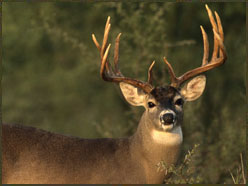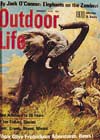During the past five years a wealth of information has been disseminated about quality deer management (QDM) and creating food plots that attract whitetails. While much of the ink has been educational, many articles omit the important ingredients that are required to turn a location into a prime-time hunting spot.
All food plots are not created equalÃÂnot by a long shot. Any successful food-plot program should provide good hunting opportunities, be set up in such a fashion as to prevent surrounding landowners from taking advantage of it and be capable of producing great nutrition for deer. This might not always be possible, but with a little forethought you can come close to creating the ideal scenario.
Once a hunter or landowner decides to invest in food plots, his first thought should be about where the plots will be located, with special emphasis on the ability to hunt them. In many ways, creating a food plot is like building a house, and laying out a food plot on a given piece of land is like the site-development stage of home building.
Where to Plant
A visually pleasing location may not be the right place for a plot for many reasons, but two of the biggest caveats are lack of good soil type and proximity to bordering properties.
The best soils will always provide the best nutrition, so you should start by testing the soil of each potential food-plot site for its pH level. Such pH soil tests can be easily and inexpensively done through county cooperative extension agencies. In most cases no seed should be planted until the soil has a pH of 6.0 or better, with a pH of 7.0 (neutral) being the best. If soils are less than 6.0 they can be made suitable for planting through liming. The agency that performs the soil test can advise you on the amount of lime and fertilizer required for specific plantings.
Once the soil is suitable for planting, the design of the food plot is critical if you wish to hunt near it. Whitetail bucks will come to a food plot during daylight only if it has the kind of cover that makes them feel comfortable using it. For this reason, food plots should be narrow and less than two acres in size. They should also have thick natural growth nearby to provide cover and escape options.
When determining a potential food-plot location, pay close attention to the way sunlight strikes the land. In most cases the best food-producing plots will face south to get more sunlight.
If your heart is set on a north-facing location, be aware that the plot will receive less sunlight, have cooler soils (which means plants will grow more slowly) and, in most cases, have soil of poorer quality.
Best Setups
It’s one thing to lay out a food plot in a great location. It’s another to be able to hunt it in such a way that you don’t spook the deer that use it. That’s why entrance and exit routes and overall stand-location sites are critical.
A food plot stuck in the center of a mature forest usually fails due to lack of sunlight, poor drainage and poor soil. Instead, place the plot along a wood’s edge and then locate a large tree close to the plot’s edge where you can hang a stand. Be sure the prevailing wind and thermal drift are in your favor. Try not to have a setup that forces you to look into the sun.
Because most deer utilize food plots on the fringe of daylight, stands set up right next to plots tend to be better afternoon locations. It’s best to place morning stands 75 to 100 yards from the food plot along a well-used trail that leads to a bedding area. It’s important to have an entrance to the stand that will not spook deer that may be feeding on the food plot at dawn. This type of morning setup will allow for an ambush when the deer leave the plot and head to their daytime bedding area.
It is possible to dictate how whitetails enter the food plot by creeating what I call “structure travel corridors” between the bedding area and the food plot. Structure can be in the form of piled brush, diversion ditches or other obstructions that force deer into a predictable travel route. Enhancing routes to and from plots in this fashion can greatly improve the hunting opportunities of a given food plot.
Protecting Your Plot
With more and more people becoming interested in quality deer management, much thought is going into food-plot layout as it relates to protecting younger bucks from being harvested by surrounding landowners who do not share the QDM philosophy. If quality deer management is one of your goals, it’s important that food plots be a minimum of 500 yards from bordering lands and close to prime bedding areas. When this rule is followed, bucks will not have to travel very far to get to the preferred food source and they’ll be at less risk of being harvested before their time.
Whitetails will always seek out the best foods available. As a result, the hunter with the best food usually wins out come harvest time. Food-plot growers typically must compete with farmers, so it’s critical that the best agricultural practices (liming, seedbed preparation, fertilizer and seeds) be used in your food-plot preparation.
Great Baits!
What you plant will vary depending on where you live, as only a few forages will work universally in North America. Again, your local cooperative extension agent can advise you on what’s best for deer in your area.
I use three types of forages on our farm in western New York state that will work in most regions of the country to attract whitetails. The seeds I use are any one of three annual winter forage grains (certified wheat, rye or triticale), Imperial Whitetail Clover and Biologic. My best results come when I plow, prepare the seedbed and plant between August 5 and 10.
If I want a clover food plot, I mix and plant annual grain and clover seed together. The annual grain seed comes up immediately, while it takes a little longer for the clover to come in. The grain seed provides a great fall attractant and by the next spring the clover has taken well, turning the plot into a lush carpet of food.
The last step with this kind of food plot is to mow the grain around the middle of June with a rotary mower or bush hog. This allows the clover to flourish. In most cases a clover food plot that is fertilized and cut each year will last three growing seasons.
My preparation for a Biologic food plot is the same as it is for clover, with the exception that I do not mix any annual grain seed with it. Within a month or so of planting, the Biologic will be lush, providing a highly nutritious food source. However, be forewarned: The Biologic is usually an annual, and if you wish to provide it for your deer each fall you’ll have to go through the planting process every year. For this reason, it’s tough to beat clover when it comes to combining nutrition, cost and longevity.

